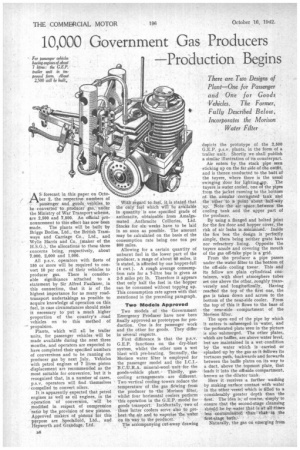10,000 Government Gas Producers Production Begins
Page 34

If you've noticed an error in this article please click here to report it so we can fix it.
S forecast in this paper on Octo ber 2, the respective numbers of passenger and goods vehkles, to be converted to producer gas; under the Ministry of War Transport scheme, are 2,500 and 7,500. An official pronouncement to this effect has now been made. The plants will be built by Briggs Bodies, Ltd., the British Tramways and Carriage Co., Ltd., and Wylie Harris and Co. (maker of the H.S.G.), the allocations to these three concerns being, respectively, about 7,000, 2,000 and 1,000.
All p.s.v. operators with fleets of 150 or more will be required to convert 10 per cent, of their vehicles to producer gas. There is considerable significance attached to a statement by Sir Alfred Faulkner, in this connection, that it is of the highest importance for as many roadtransport undertakings as possible to acquire knowledge of operation on this fuel, in case circumstances should make it necessary to' put a mach higher proportion of the country's -road vehicles on to this method of propulsion.
Plants, which will all be trailer units, for passenger vehicles will be made available during the next three months, and operators are expected to have completed their specified numbers of conversions and to be running on producer gas by next July. Vehicles with petrol engines of 7 litres piston displacement are recommended as the most suitable for conversion; but it is recognized that, in a number of cases, p.s.v, operators will find themselves compelled to convert oilers.
It is apparently expected that petrol engines as well as oil engines, in the operation of conversion, will be 'modified in respect of compression ratio by the provision of new pistons. Approved makers of piston for this purpose are Specialloid, Ltd., and Hepworth and Granda,ge, Ltd.
With regard to fuel, it is stated that the only fuel which win be available in quantity is one specified grade of anthracite, obtainable from Amalgamated Anthracite Collieries, Ltd. Stocks for six weeks have to be laid in so soon as possible. The amount may be calculated on the basis of the consumption rate being one ton per 800 miles.
Allowing for a certain quantity of unbarnt fuel in the lower part of the producer, a range of about 80 miles, it is stated, is afforded by one hopper-full (4 cwt.). A rough average consumption rate for a 7-litre bus is given as 2-3 miles per lb. Therefore it appears that only half the fuel in the hopper can be consumed without topping up. This consumption rate agrees with that mentioned in the preceding paragraph.
Two Models Approved Two models of the Government Emergency Producer have now been finally approved as prototypes for production. One is for passenger work and the other for goods. They differ in several respects.
First difference. is that the p.s.v. G.E.P. functions on the dry-blast system, whilst the other uses a wet blast with pre-heating. Secondly,. the Morison water filter is employed for the passenger model and the
mineral-wool unit for the goods-vehicle plant. Thirdly, gascooling arrangements are different. Two vertical cooling towers reduce the temperature of the gas flowing from the producer to .the Morison filter, whilst four horizontal coolers perform -this operation in the G.E.P. model for goods transport. Incidentally; ntwo of these latter coolers serve • also to preheat the air.and to vaporize the water on its way to the producer.
The accompanying cut-away drawing depicts the prototype of the 2,500 G.E.P. p.s.v. plants, in the form of a trailer unit. Shortly we shall publish a similar illustration of its counterpart.
Air enters by the stack pipe seen sticking up on the far side of the outfit, and is thence conducted to the butt of the tuyere, where there is the usual
swinging -door for lightingqpp. 'The tuyere is water cooled, one of the pipes from the jacket running to the bottom of the. annular Corrugated tank and the her to a point about half-way up: 14.lote the air space. between the cooling tank and the upper part of the producer.
By using a flanged and bolted joint for the fire door and hopper cover, .tbe risk of air leaks is. minimized. Inside the fire box the design is perfectly simple, there being neither grate bars nor refractory lining. Opposite the tuyere nozzle and covering the mouth of the gas off-take pipe is a grid.
From the producer a pipe passes under the water filter to the bottom of the off-side cooling tower. This and its fellow are plain cylindrical containers, with short atmosphere tubes set one above the other, roughly transversely and longitudinally. Having reached the top of the first one, the gas is taken down and across to the bottom of the near-side cooler. From the top of this it flows to the base of the near-side compartment of the Morison filter.
The open end of the pipe by which it enters is submerged in water, and the perforated plate 'seenin the picture is also submerged. The other plates, which are baffles, are above water level, but are maintained in a wet condition by the water which is carried or splashed up by the gas as it follows its tortuous path, backwards and forwards between the baffle plates on. its way to a duct, above the topmost plate, that leads it into the off-side compartment, known as the dilutor tank.
Here it receives a further washing by making surface contacA with water in the other vessel which is filled to a considerably greater depth than the -first. The idea is, of course, simply' to ensure that the second-stage cleansing should be by water that is at all.tiraes leas oontaminated than that— in the trst-stage bath., • • Naturally, the gas on emerging from




























































